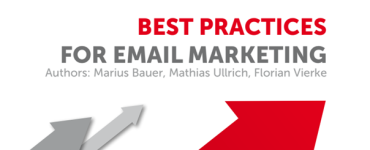The email is more dynamic than ever and is an important element of the marketing mix. But some marketers unfortunately treat email marketing, privacy, and data security far too casually. This has ramifications not just for deliverability, but also for the company’s reputation. Furthermore, from May 2018, violations of the new EU General Data Protection Regulation (GDPR) will be liable to severe financial penalties. The Certified Senders Alliance (CSA) provides ten tips to help advertisers in 2018 to avoid mistakes in mailings, to stay on the right legal path, and to carry out successful email campaigns.
Double opt-in is a must
According to the new GDPR, mass mailers of emails must be able to prove at any time and for each individual case that they have the recipient’s consent for sending the email. This permission must be voluntary, active, explicit, separate, and specific to the concrete case. In the so-called double opt-in procedure (DOI), a recipient wanting to register for a newsletter has to click again on a confirmation link within a confirmation mail. This means that you as the sender have the active consent of the recipient and are legally protected. For you as the sender of advertising mails, DOI is a must. Use this procedure and document it so that you can prove consent in case of doubt.
You are responsible
As an advertising company, you are responsible for ensuring that all GDPR requirements are adhered to when sending your mailings, and you are also liable in the event of a violation. However, not only you alone, but also your email service provider (ESP) bears responsibility and must comply with the rules of the GDPR. So think carefully about whose services you use for your mailings.
Obligation to be transparent
When collecting personal data, you have a duty to inform the person concerned. In principle, you must therefore inform everyone who subscribes to a newsletter, for example, about what happens with the data collected – in terms of when, where, and by whom it is handled.
Class instead of mass
According to a recent study, only about a quarter of all advertising emails sent are opened at all. Which is hardly surprising, given that more than 20,000 emails are booked per second in Germany. If you don’t want your emails to end up unopened in the recycle bin, you need to do more than just click the Send button. Design your advertising emails carefully, so that the recipient’s attention is captured immediately by the unopened version and she/he is enticed to read on.
Timing is (almost) everything
Provide your customers with the information that they need, when they need it. Meet your target group wherever they are on their “customer journey”. Use your advertising mailings so that the journey ends exactly where you want it to: with your product.
Always stay clean
While you naturally want to get your messages across to as wide an audience as possible, you also need to keep your mailing lists clean. If you send unsolicited emails, not only will your reputation suffer, but you will also face severe penalties. Use the following tips to ensure a greater degree of “list hygiene”.
Keep it simple
Of course, you want as many people as possible to subscribe to and read your newsletter. But don’t make it too difficult for your subscribers to unsubscribe. A subscriber who doesn’t manage to unsubscribe quickly and easily from your newsletter will be just as quickly annoyed, and your mails will be redirected just as quickly to their spam folder. And that is doubly aggravating. So, even though you might not like it at first glance: make the de-registration procedure as simple as possible. Use a List-Unsubscribe header as recommended by the CSA for some time now. Apply the new RFC standard 8058 (one-click-unsubscribe) so that the recipient can comfortably unsubscribe with one (mouse) click. This also prevents subscribers from being inadvertently de-registered, for example, by anti-spam programs. But make sure that the List-Unsubscribe header is part of the DKIM signature.
Contact Management
Another important aspect of clean distribution lists is the way you handle returns, i.e. bounce handling. Immediately delete so-called hard bounces – i.e. incorrect or missing mail addresses or domains – from the distribution list. And again: Use double opt-in to prevent hard bounces caused by incorrect or non-existent mail addresses occurring in the first place.
Deliverability
Some companies pay far too little attention to the deliverability of their advertising emails. Make sure that your address database is always up-to-date and maintained (list hygiene) and make sure that you do not appear on a blacklist. This not only reduces deliverability; it also damages your good reputation.
Last but not least: Be fair
Honesty and transparency play a major role in email marketing. If you treat your recipients in the same way as you yourself would like to be treated, then you’re attending to your good reputation. This way you win your customer’s confidence, you can depend on the ISPs to forward your mails, and you have nothing to fear from the regulatory authorities.
This and similar email-related topics will also be discussed by international experts at the CSA Summit 2018. You can find further information here: https://summit.certified-senders.eu




